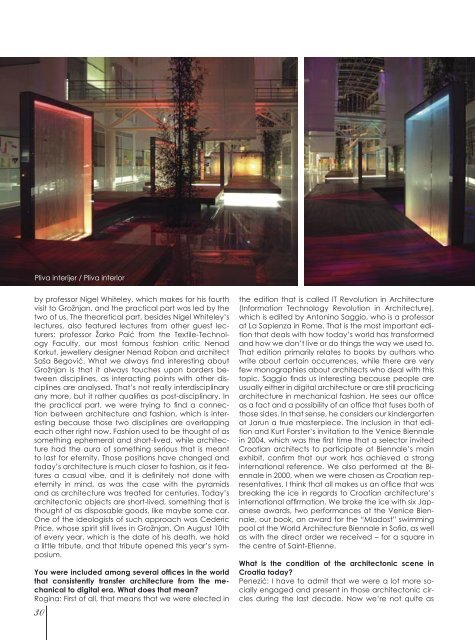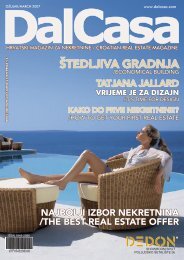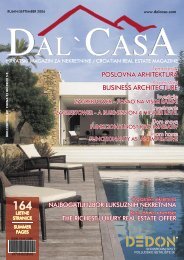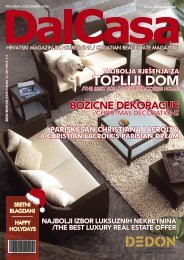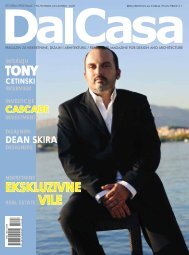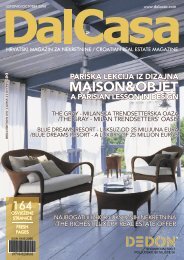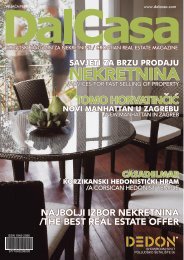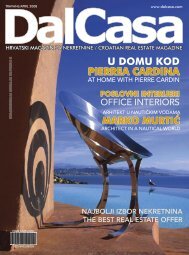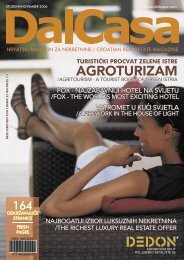100% DESIGN LONDON - DalCasa
100% DESIGN LONDON - DalCasa
100% DESIGN LONDON - DalCasa
Create successful ePaper yourself
Turn your PDF publications into a flip-book with our unique Google optimized e-Paper software.
Pliva interijer / Pliva interior<br />
by professor Nigel Whiteley, which makes for his fourth<br />
visit to Grožnjan, and the practical part was led by the<br />
two of us. The theoretical part, besides Nigel Whiteley’s<br />
lectures, also featured lectures from other guest lecturers:<br />
professor Žarko Paić from the Textile-Technology<br />
Faculty, our most famous fashion critic Nenad<br />
Korkut, jewellery designer Nenad Roban and architect<br />
Saša Begović. What we always find interesting about<br />
Grožnjan is that it always touches upon borders between<br />
disciplines, as interacting points with other disciplines<br />
are analysed. That’s not really interdisciplinary<br />
any more, but it rather qualifies as post-disciplinary. In<br />
the practical part, we were trying to find a connection<br />
between architecture and fashion, which is interesting<br />
because those two disciplines are overlapping<br />
each other right now. Fashion used to be thought of as<br />
something ephemeral and short-lived, while architecture<br />
had the aura of something serious that is meant<br />
to last for eternity. Those positions have changed and<br />
today’s architecture is much closer to fashion, as it features<br />
a casual vibe, and it is definitely not done with<br />
eternity in mind, as was the case with the pyramids<br />
and as architecture was treated for centuries. Today’s<br />
architectonic objects are short-lived, something that is<br />
thought of as disposable goods, like maybe some car.<br />
One of the ideologists of such approach was Cederic<br />
Price, whose spirit still lives in Grožnjan. On August 10th<br />
of every year, which is the date of his death, we hold<br />
a little tribute, and that tribute opened this year’s symposium.<br />
You were included among several offices in the world<br />
that consistently transfer architecture from the mechanical<br />
to digital era. What does that mean<br />
Rogina: First of all, that means that we were elected in<br />
30<br />
the edition that is called IT Revolution in Architecture<br />
(Information Technology Revolution in Architecture),<br />
which is edited by Antonino Saggio, who is a professor<br />
at La Sapienza in Rome. That is the most important edition<br />
that deals with how today’s world has transformed<br />
and how we don’t live or do things the way we used to.<br />
That edition primarily relates to books by authors who<br />
write about certain occurrences, while there are very<br />
few monographies about architects who deal with this<br />
topic. Saggio finds us interesting because people are<br />
usually either in digital architecture or are still practicing<br />
architecture in mechanical fashion. He sees our office<br />
as a fact and a possibility of an office that fuses both of<br />
those sides. In that sense, he considers our kindergarten<br />
at Jarun a true masterpiece. The inclusion in that edition<br />
and Kurt Forster’s invitation to the Venice Biennale<br />
in 2004, which was the first time that a selector invited<br />
Croatian architects to participate at Biennale’s main<br />
exhibit, confirm that our work has achieved a strong<br />
international reference. We also performed at the Biennale<br />
in 2000, when we were chosen as Croatian representatives.<br />
I think that all makes us an office that was<br />
breaking the ice in regards to Croatian architecture’s<br />
international affirmation. We broke the ice with six Japanese<br />
awards, two performances at the Venice Biennale,<br />
our book, an award for the “Mladost” swimming<br />
pool at the World Architecture Biennale in Sofia, as well<br />
as with the direct order we received – for a square in<br />
the centre of Saint-Etienne.<br />
What is the condition of the architectonic scene in<br />
Croatia today<br />
Penezić: I have to admit that we were a lot more socially<br />
engaged and present in those architectonic circles<br />
during the last decade. Now we’re not quite as


